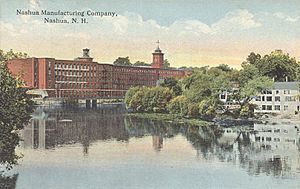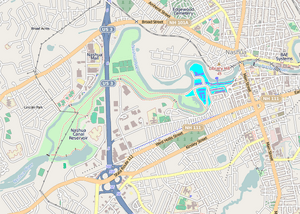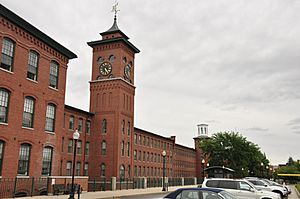Nashua Manufacturing Company facts for kids

The Nashua Manufacturing Company was a big factory in Nashua, New Hampshire. It made cotton cloth and other fabrics. This company was open from 1823 to 1945. It was one of many companies that helped build the city of Nashua. They even helped create roads, churches, and their own bank! Like many factories in New England, it faced tough times during the Great Depression. The company closed after World War II. This happened because many factories moved to the Southern United States. They could find cheaper workers and land there.
A Look Back: The Company's Story

Nashua was one of several towns built along the Merrimack River. These towns used the river's strong currents to power their factories. This was during the early days of the Industrial Revolution. That's when machines started doing work that people used to do by hand. Other famous factories were the Merrimack mills in Lowell, Massachusetts and the Amoskeag mills in Manchester, New Hampshire. You can even visit the Millyard Museum in Manchester today!
The Nashua Manufacturing Company started in 1823. A man named Daniel Abbot helped make it happen. He is sometimes called the "father of Nashua." He was part of the town when its name changed from Dunstable to Nashua in 1837. Daniel Abbot and other citizens bought land along the Nashua River. They bought land from the Merrimack River all the way to Mine Falls. They planned to use the power from these falls to run their factories.
They hired a designer named Asher Benjamin to plan the factories. He also designed churches and a street layout for the town. The company helped pay for digging the Nashua power canal. This canal brought water from the river to power the mills. After the canal was finished, the company built more factory buildings. They also hired more workers. This likely helped the town's population grow a lot between 1820 and 1830.
In 1835, one of the company's founders also started the Nashua Bank. This bank later became known as the Indian Head Bank. It even printed its own money! The Nashua Manufacturing Company grew very large. It bought several other fabric-making companies over the years. These included the Jackson Company and the Indian Head Mills. The company owned a huge area of land, about 400 acres. Today, much of this land is protected as Mine Falls Park. The area where the old factories stood is now called the Nashua Manufacturing Company Historic District.
The company was bought by Textron Inc. in 1945. In 1947, Textron combined the operations of several factories.
Today, some of the old factory buildings along the Nashua River have new life. In the early 2000s, six of these buildings were turned into apartments. They are now known as Clocktower Place Apartments.


